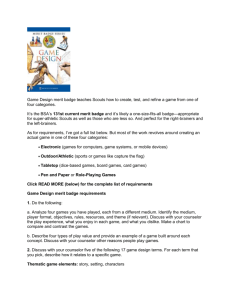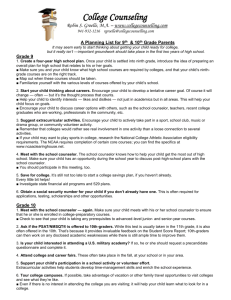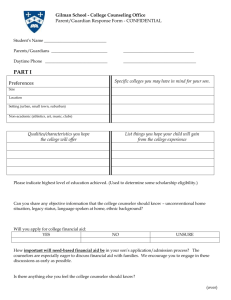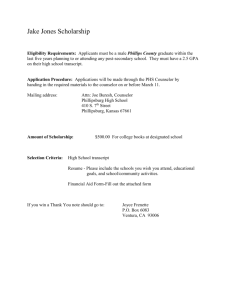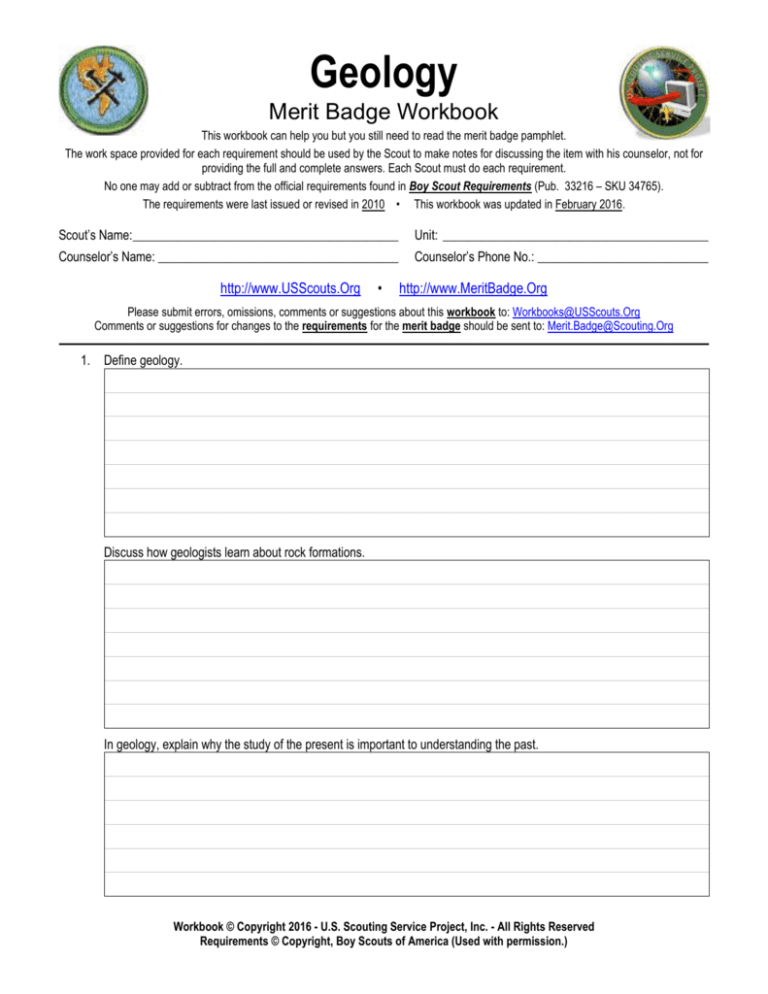
Geology
Merit Badge Workbook
This workbook can help you but you still need to read the merit badge pamphlet.
The work space provided for each requirement should be used by the Scout to make notes for discussing the item with his counselor, not for
providing the full and complete answers. Each Scout must do each requirement.
No one may add or subtract from the official requirements found in Boy Scout Requirements (Pub. 33216 – SKU 34765).
The requirements were last issued or revised in 2010 • This workbook was updated in February 2016.
Scout’s Name:__________________________________________
Unit: __________________________________________
Counselor’s Name: ______________________________________
Counselor’s Phone No.: ___________________________
http://www.USScouts.Org
•
http://www.MeritBadge.Org
Please submit errors, omissions, comments or suggestions about this workbook to: Workbooks@USScouts.Org
Comments or suggestions for changes to the requirements for the merit badge should be sent to: Merit.Badge@Scouting.Org
______________________________________________________________________________________________________________________________________________
1. Define geology.
Discuss how geologists learn about rock formations.
In geology, explain why the study of the present is important to understanding the past.
Workbook © Copyright 2016 - U.S. Scouting Service Project, Inc. - All Rights Reserved
Requirements © Copyright, Boy Scouts of America (Used with permission.)
Geology
Scout's Name: ________________________
2. Pick three resources that can be extracted or mined from Earth for commercial use. Discuss with your counselor how
each product is discovered and processed.
Resource
How discovered
Processed
Resource
How discovered
Processed
Resource
How discovered
Processed
Geology - Merit Badge Workbook
Page. 2 of 8
Geology
Scout's Name: ________________________
3. Review a geologic map of your area or an area selected by your counselor, and discuss the different rock types and
estimated ages of rocks represented. Determine whether the rocks are horizontal, folded, or faulted, and explain how
you arrived at your conclusion
Rock Type
Age
Horizontal, Folded, or Faulted
How you arrived at your conclusions
4. Do ONE of the following:
a. With your parent's and counselor's approval, visit with a geologist, land use planner, or civil engineer. Discuss
this professional's work and the tools required in this line of work.
Geology - Merit Badge Workbook
Page. 3 of 8
Geology
Scout's Name: ________________________
Learn about a project that this person is now working on, and ask to see reports and maps created for this
project.
Discuss with your counselor what you have learned.
b. Find out about three career opportunities available in geology.
1.
2.
3.
Pick one and find out the education, training, and experience required for the profession.
Career:
Education:
Training:
Geology - Merit Badge Workbook
Page. 4 of 8
Geology
Scout's Name: ________________________
Experience:
Discuss this with your counselor, and explain why this profession might interest you.
5. Complete ONE of the options listed below (a OR b OR c OR d):
(Use a blank page to record any information requested in any of the options)
a. Surface and Sedimentary Processes Option
1. Conduct an experiment approved by your counselor that demonstrates how sediments settle from
suspension in water. Explain to your counselor what the exercise shows and why it is important.
2. Using topographical maps provided by your counselor, plot the stream gradients (different elevations
divided by distance) for four different stream types (straight, meandering, dendritic, trellis). Explain
which ones flow fastest and why, and which ones will carry larger grains of sediment and why.
3. On a stream diagram, show areas where you will ,find the following features: cut bank, fill bank, point
bar, medial channel bars, lake delta. Describe the relative sediment grain size found in each feature.
4. Conduct an experiment approved by your counselor that shows how some sedimentary material
carried by water may be too small for you to see without a magnifier.
5. Visit a nearby stream. Find clues that show the direction of water flow, even if the water is missing.
Record your observations in a notebook, and sketch those clues you observe. Discuss your
observations with your counselor.
b. Energy Resources Option
1. List the top five Earth resources used to generate electricity in the United States.
2. Discuss source rock, trap, and reservoir rock - the three components necessary for the occurrence of
oil and gas underground.
3. Explain how each of the following items is used in subsurface exploration to locate oil or gas: reflection
seismic, electric well logs, stratigraphic correlation, offshore platform, geologic map, subsurface
structure map, subsurface isopach map, and core samples and cutting samples.
Geology - Merit Badge Workbook
Page. 5 of 8
Geology
Scout's Name: ________________________
4. Using at least 20 data points provided by your counselor, create a subsurface structure map and use it
to explain how subsurface geology maps are used to find oil, gas, or coal resources.
5. Do ONE of the following activities:
a. Make a display or presentation showing how oil and gas or coal is found, extracted, and
processed. You may use maps, books, articles from periodicals, and research found on the
Internet (with your parent's permission). Share the display with your counselor or a small
group (such as your class at school) in a five minute presentation.
b. With your parent's and counselor's permission and assistance, arrange for a visit to an
operating drilling rig. While there, talk with a geologist and ask to see what the geologist does
onsite. Ask to see cutting samples taken at the site.
c. Mineral Resources Option
1. Define rock. Discuss the three classes of rocks including their origin and characteristics.
2. Define mineral. Discuss the origin of minerals and their chemical composition and identification
properties, including hardness, specific gravity, color, streak, cleavage, luster, and crystal form.
3. Do ONE of the following:
a. Collect 10 different rocks or minerals. Record in a notebook where you obtained (found,
bought, traded) each one. Label each specimen, identify its class and origin, determine its
chemical composition, and list its physical properties. Share your collection with your
counselor.
b. With your counselor's assistance, identify 15 different rocks and minerals. List the name of
each specimen, tell whether it is a rock or mineral, and give the name of its class (if it is a
rock) or list its identifying physical properties (if it is a mineral).
4. List three of the most common road building materials used in your area. Explain how each material is
produced and how each is used in road building.
5. Do ONE of the following activities:
a. With your parent's and counselor's approval, visit an active mining site, quarry, or sand and
gravel pit. Tell your counselor what you learned about the resources extracted from this
location and how these resources are used by society.
b. With your counselor, choose two examples of rocks and two examples of minerals. Discuss
the mining of these materials and describe how each is used by society.
c. With your parent's and counselor's approval, visit the office of a civil engineer and learn how
geology is used in construction. Discuss what you learned with your counselor.
d. Earth History Option
1. Create a chart showing suggested geological eras and periods. Determine which period the rocks in
your region might have been formed.
2. Explain to your counselor the processes of burial and fossilization, and discuss the concept of
extinction.
3. Explain to your counselor how fossils provide information about ancient life, environment, climate, and
geography. Discuss the following terms and explain how animals from each habitat obtain food:
benthonic, pelagic, littoral, lacustrine, open marine, brackish, fluvial, eolian, protected reef.
4. Collect 10 different fossil plants or animals OR (with your counselor's assistance) identify 15 different
fossil plants or animals. Record in a notebook where you obtained (found, bought, traded) each one.
Classify each specimen to the best of your ability, and explain how each one might have survived and
obtained food. Tell what else you can learn from these fossils.
Geology - Merit Badge Workbook
Page. 6 of 8
Geology
Scout's Name: ________________________
5. Do ONE of the following:
a. Visit a science museum or the geology department of a local university that has fossils on
display. With your parent's and counselor's approval, before you go, make an appointment
with a curator or guide who can show you how the fossils are preserved and prepared for
display.
b. Visit a structure in your area that was built using fossiliferous rocks. Determine what kind of
rock was used and tell your counselor the kinds of fossil evidence you found there.
c. Visit a rock outcrop that contains fossils. Determine what kind of rock contains the fossils,
and tell your counselor the kinds of fossil evidence you found at the outcrop.
d. Prepare a display or presentation on your state fossil. Include an image of the fossil, the age
of the fossil, and its classification. You may use maps, books, articles from periodicals, and
research found on the Internet (with your parent's permission). Share the display with your
counselor or a small group (such as your class at school). If your state does not have a state
fossil, you may select a state fossil from a neighboring state.
Requirement resources can be found here:
http://www.meritbadge.org/wiki/index.php/Geology#Requirement resources
Geology - Merit Badge Workbook
Page. 7 of 8
Important excerpts from the Guide To Advancement - 2013, No. 33088 (SKU-618673)
[1.0.0.0] — Introduction
The current edition of the Guide to Advancement is the official source for administering advancement in all Boy Scouts of America programs: Cub
Scouting, Boy Scouting, Varsity Scouting, Venturing, and Sea Scouts. It replaces any previous BSA advancement manuals, including Advancement
Committee Policies and Procedures, Advancement and Recognition Policies and Procedures, and previous editions of the Guide to Advancement.
[Page 2, and 5.0.1.4] — Policy on Unauthorized Changes to Advancement Program
No council, committee, district, unit, or individual has the authority to add to, or subtract from, advancement requirements. There are limited
exceptions relating only to youth members with special needs. For details see section 10, “Advancement for Members With Special Needs”.
[Page 2] — The “Guide to Safe Scouting” Applies
Policies and procedures outlined in the Guide to Safe Scouting, No. 34416, apply to all BSA activities, including those related to advancement and
Eagle Scout service projects.
[7.0.3.1] — The Buddy System and Certifying Completion
A youth member must not meet one-on-one with an adult. Sessions with counselors must take place where others can view the interaction, or the
Scout must have a buddy: a friend, parent, guardian, brother, sister, or other relative—or better yet, another Scout working on the same badge—along
with him attending the session.
When the Scout meets with the counselor, he should bring any required projects. If these cannot be transported, he should present evidence, such as
photographs or adult verification. His unit leader, for example, might state that a satisfactory bridge or tower has been built for the Pioneering merit
badge, or that meals were prepared for Cooking. If there are questions that requirements were met, a counselor may confirm with adults involved.
Once satisfied, the counselor signs the blue card using the date upon which the Scout completed the requirements, or in the case of partials, initials
the individual requirements passed.
Note that from time to time, it may be appropriate for a requirement that has been met for one badge to also count for another. See “Fulfilling More
Than One Requirement With a Single Activity,” 4.2.3.6.
[7.0.3.2] — Group Instruction
It is acceptable—and sometimes desirable—for merit badges to be taught in group settings. This often occurs at camp and merit badge midways or
similar events. Interactive group discussions can support learning. The method can also be attractive to “guest experts” assisting registered and
approved counselors. Slide shows, skits, demonstrations, panels, and various other techniques can also be employed, but as any teacher can attest,
not everyone will learn all the material.
There must be attention to each individual’s projects and his fulfillment of all requirements. We must know that every Scout —actually and
personally— completed them. If, for example, a requirement uses words like “show,” “demonstrate,” or “discuss,” then every Scout must do that. It is
unacceptable to award badges on the basis of sitting in classrooms watching demonstrations, or remaining silent during discussions.
It is sometimes reported that Scouts who have received merit badges through group instructional settings have not fulfilled all the requirements. To
offer a quality merit badge program, council and district advancement committees should ensure the following are in place for all group instructional
events.
Merit badge counselors are known to be registered and approved.
Any guest experts or guest speakers, or others assisting who are not registered and approved as merit badge counselors, do not accept the
responsibilities of, or behave as, merit badge counselors, either at a group instructional event or at any other time. Their service is temporary, not
ongoing.
Counselors agree not to assume prerequisites have been completed without some level of evidence that the work has been done. Pictures and
letters from other merit badge counselors or unit leaders are the best form of prerequisite documentation when the actual work done cannot be
brought to the camp or site of the merit badge event.
There is a mechanism for unit leaders or others to report concerns to a council advancement committee on summer camp merit badge programs,
group instructional events, and any other merit badge counseling issues—especially in instances where it is believed BSA procedures are not
followed. See “Reporting Merit Badge Counseling Concerns,” 11.1.0.0.
There must be attention to each individual’s projects and his fulfillment of all requirements. We must know that every Scout—actually and
personally—completed them.
[7.0.3.3] — Partial Completions
A Scout need not pass all the requirements of one merit badge with the same counselor. It may be that due to timing or location issues, etc., he must
meet with a different counselor to finish the badge. The Application for Merit Badge has a place to record what has been finished—a “partial.” In the
center section on the reverse of the blue card, the counselor initials for each requirement passed. In the case of a partial completion, the counselor
does not retain his or her portion of the card. A subsequent counselor may choose not to accept partial work, but this should be rare. A Scout, if he
believes he is being treated unfairly, may work with his unit leader to find another counselor. An example for the use of a signed partial would be to
take it to camp as proof of prerequisites. Partials have no expiration except the Scout’s 18th birthday. Units, districts, or councils shall not establish
other expiration dates for partial merit badges.
[7.0.4.8] — Unofficial Worksheets and Learning Aids
Worksheets and other materials that may be of assistance in earning merit badges are available from a variety of places including unofficial sources
on the Internet and even troop libraries. Use of these aids is permissible as long as the materials can be correlated with the current requirements that
Scouts must fulfill. Completing “worksheets” may suffice where a requirement calls for something in writing, but this would not work for a requirement
where the Scout must discuss, tell, show, or demonstrate, etc. Note that Scouts shall not be required to use these learning aids in order to complete a
merit badge.
Attachment
(NOTE: It is not necessary to print this page.)
Page 8 of 8


